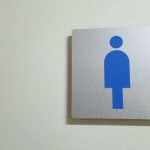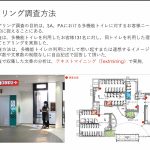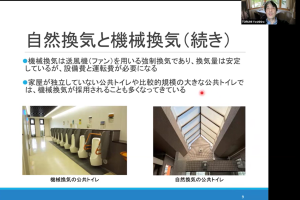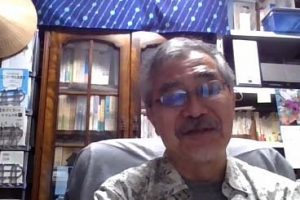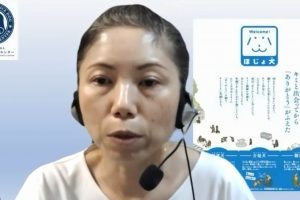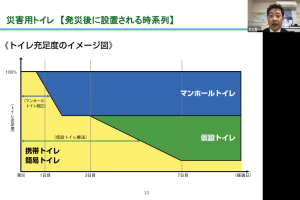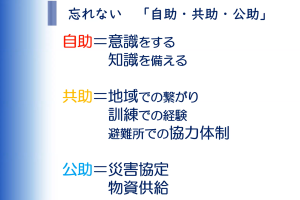Japan Toilet Association (JTA) Seminar Series,
“Let us know more about our toilet story”
Title: The 8th seminar “Reconsideration of toilet functional distribution
-Measures to disperse the use of multi-functional toilets”
Date: 16 December 2021 (Thu) 18:00-20:00 JST
Presenter:
Part 1: Koji Yamamoto, Ph.D., Japan Toilet Association steering committee member, Central Nippon Expressway Company Limited.
Part 2: Yoshihiko Kawauchi, Ph.D., Japan Toilet Association vice chairperson, former professor of Toyo University.
Today’s talk is different from the design standards by NEXCO Central Japan, and this research is limited to the rest areas under the special circumstances in NEXCO Central Japan. This company constructs new express ways, renovates, maintains and repairs them. It used to be called the Japan Highway Public Corporation. It was divided in 2005 into three companies: NEXCO East Japan, Central Japan and West Japan. We have been trying to improve the rest areas toilets (Service Area (SA) / Parking Area (PA)), and we are developing many unique trials wishing that our rest areas will be ideal spots for our custom drivers.
- Our research background from 2013
We started research following to the policy for toilet functional distribution mentioned in the accessibility design standard in 2012 by the Ministry of Land, Infrastructure, Transport and Tourism. NEXCO Central Japan have installed multi-functional toilets, family toilets, and large cubicles that can be used by the wheelchairs in both gender toilet (simple multi-functional toilets), and General cubicles in all SA/PA.
There were many complaints about shortage of multi-functional toilets, and then we tried to increase the number. However, the number of multi-functional toilets was calculated based on our analysis, it was difficult to increase the number. Instead, we created a family toilet which is a multi-functional toilet added a child bowl.
Furthermore, toilets for ostomates have been equipped by the request from Japan Ostomy Association. They were placed in the innermost part of the men’s and women’s toilets.
In recent years, there become issues that multi-functional toilets are becoming more difficult for people with disabilities to use due to the frequent use by families with children, etc. Therefore, we studied by surveying (1) the actual usage conditions of multi-functional toilets, (2) the needs of users and analyzed.
- Analysis of the actual usage of multi-functional toilets
We quantitatively analyzed by the actual usage of multi-functional toilets based on Poisson distribution about what kind of people such as disabled people, elderly people, non-disabled people, families and gender, use which type of the toilets. The users randomly visit the toilets at SA/PA or the commercial facilities and the queue analysis performed in such an event. The number of toilets can be calculated by this analysis with the probability of the user arrival at the toilet, the time to use it, and the tolerant waiting time of the toilet. This method can be also applied to calculate that number of ticket gates at stations, elevators in buildings and highway tollgates.
This queue analysis started in 2007. When two or three express buses with 20 or 30 passengers successively arrived at SA/PA, a long queue is generated inevitably. A simulation model was created based on the hearing that they can wait for about 2 minutes. However, it does not mean that they can use toilets less than 2 minutes, but the probability of waiting for more than 2 minutes is 0.01%.
When many buses arrive all at once, the instant number of users will exceed the number of toilet bowls, and then users must inevitably wait in the queue. In this case Poisson distribution can be applied, since SA/PA toilet users will visit by buses or private cars and they visit there randomly.
The log sensors were installed in some SA/PA toilet cubicles. It has a magnet sensor on the door to count when the door closes to use. The user’s private attributes of multi-functional toilets cannot be detected by this log sensor. It is comparatively possible to observe the user attributes with the security camera at the toilet entrance under the ethical management. This analysis was supported by Professor G. Takahashi of Toyo University.
The families often used the multi-functional toilet at Ebina service area. The disabled users staying time was 5 minutes and 37 seconds, whereas general families stayed 4 minutes 11 seconds. They are staying much longer than staying in regular cubicles. This means that there was not only multiple use but also changing diapers.
The visitors number of Ebina service area is about 50,000 a day and about 100 disable users among them. 1,000 non-disabled users used multi-functional toilets, and 91% of the users were non-disabled users and the remaining 9% were disabled ones. It was observed that the multi-functional toilet shortage reason due to the overwhelming non-disabled users including children and the elderly people using multi-functional toilets.
Since disabled uses are about 100 people a day, it is difficult to increase the number of toilet bowls simply based on the user number. When disabled user uses the toilet for 5 minutes, the next one will have to wait 5 minutes when the next user arrives immediately. If there is another toilet besides and it is used randomly, then the waiting time must be much shorter. When deciding the number of multi-functional toilets, it is effective to refer to the relationship among users’ profiles, frequency of users’ arrival, and how it affects the next user when the usage time is long. If you don’t sort out that, you won’t be able to see the answer.
There was a queue in the multi-functional toilet in the Ebina service area. If only wheelchair users are permitted to use multi-functional toilets, current two cubicles should be enough. However, in reality, the families are also willing to use the multi-functional toilet and in the case of hetero gender care, they are not be able to enter the gender-separated toilets. For these reasons, it seems there are unsolved problems in toilet functional distribution.
- A survey of the multi-functional toilet usage
We asked 131 users who used multi-functional toilets about the reason why they use there. Most of their reasons were with children, physically disabled and using a wheelchair. The wheelchair users naturally have the highest priority to use multi-functional toilets, but it was found that a lot of family users demanded to use there as well.
The definition of functional distribution toilet is to keep the wheelchair needs at first and then prepare extra toilets for the others. However, there are some users with the different gender support who cannot afford to use gender separated toilets. Therefore, a simple replacement from the multi-function toilets to the functional distributed toilets cannot solve the congestion at SA/PA toilet. It must be necessary to consider that there are reasons that some non-disabled people are also necessary to use those multi-functional toilets.
- A consideration of multi-functional toilets based on the survey results
4.1 The required toilet bowl numbers in the multi-functional toilet
Based on this survey, thinking on the premise that people with disabilities and families with children use multi-functional toilets, we discussed with DPI-Japan (Japan National Assembly of Disabled Peoples’ International). DPI-Japan commented that if waiting time is less than 2 minutes, they can afford to share it with family use.
4.2 A consideration on additional simple function for wheelchair users in the general toilets
If the wheelchair users can select several toilets, they can reduce the waiting time. For that purpose, wheelchairs will be able to use not only multi-functional toilets but also large cubicles in men’s and women’s toilets. If there are additional number of large cubicles, they have more choices even though not covering all wheelchair users.
The experiment was conducted with the collaboration of COMANY Inc. and the wheelchair users in DPI-Japan. Then the current cubicle is 110 cm wide and 160 cm depth, but it can be used easier by them with a folding door and 180 cm depth.
By means of the number increasement of large cubicles in the men’s and women’s toilets, they will wait shorter time and they have more options for self-operational wheelchairs.Consequently the waiting queue can be reduced if we can further promote the use distribution.
4.3 Adding wheelchair accessible simple cubicle in the general toilets
One multi-functional toilet cubicle added in the Ebina service area. In addition, in order to increase the choices for wheelchair users, one new cubicle with a folding door was experimentally added in the men’s toilet. Previously there were three cubicles; they are a large one, a crouching style one and an for-ostomate one, and then we changed them into for-ostomate cubicles and wheelchair-accessible ones increasing the cubicle numbers. The reason for increasing the number is that there is a tendency that men’s user use toilet bowls instead of the urinals. The four cubicles in the first row from the entrance are all wheelchair accessible ones. The toilet for the ostomates is also available at the end.
4.4 The evaluation of wheelchair accessible simple cubicle
We asked a wheelchair user of the DPI-Japan to try to use these toilets. Since the size of each wheelchair is different, not always everyone can use the large cubicles in the general toilet, but their comments were favorable to additional functional toilets or the distributed options in the general toilet.
- Conclusion
We verified the number of toilet bowls required in the multi-functional toilets. In fact, Ebina service area is the only place where the number of toilet bowls was insufficient. Currently in other SA/PA there are not queued so far. However, since the usage situation may gradually change, it will be necessary to add some more large cubicles in the general toilet in SA/PA.
【Q&A- Part 1】
[Q: T] Is it possible to make the folding door space smaller by increasing the number of folding parts? [A: Yamamoto] We still don’t really trust folding doors, so we didn’t add more hinges. There are the folding doors at the other parking area where one of the two parts is slightly larger to reduce the folding space. [A: Kawauchi] When too many folding parts, the thickness of the door increases when folded, and then the wider entrance space is necessary consequently.[Q: H] I heard that the cubicles in the back are often neglected to use. Have you considered this factor in this research? [A: Yamamoto] This mathematical queue analysis did not include it. We analyzed up to the relations among numbers of the cubicles, how likely it is that users will come and how likely they will be used. [A: Kawauchi] I’ve heard that NEXCO Central Japan is designing to brighten the back by applying Savanna effect which people are led to the bright area.
[Q: H] Have you seen people who smoke or make up in the multi-functional toilets? [A: Yamamoto] Our research did not give an information of how it was used. However, it seems that some truck drivers were brushing their teeth there. [A: Kawauchi] In the service area, I think there are few “other people” smoking or making up, etc. who are found in the city public toilet. The other way they can smoke outdoors and make up in various places in the service area and even in their cars.
【Part 2】
- Rethinking about the toilet functional distribution
-including usage distribution by the multi-function toilets
6.1 Rising issues of the multi-functional toilets
The issue of the multi-functional toilets was announced by the Ministry of Land, Infrastructure, Transport and Tourism in 2012. It was pointed out that the number of elderly people and users with children to multi-functional toilets are increasing, then it bothers for wheelchair users to use. Then it was proposed to decentralize the individual functions such as installing equipment for infants and ostomates in the general toilets. I cannot agree this method since there must be better other ways to alleviate congestion besides reducing the users who use multi-functional toilets. I will point out the issue becomes apparent due to the functional decentralization.
6.2 Issues become apparent due to functional decentralization -1
6.2.1 The difficulty to guide users to distributed individual function toilets
I think even if we educate the toilet users about the distribution of functions, it will take time to penetrate them, and we have to guide people who do not know it by the pictogram signs. I am worried that it will be quite difficult to change the usage of multi-functional toilets that have already become their common sense.
6.2.2 Users may not feel like using a multi-functional toilet
Even though persuasive ideas, there will not change in the toilet usage behavior. Once a user is accustomed to use one conveniently, then it must be hard to ask to use a different one for yielding to wheelchair users.
6.2.3 Measures for heterosexual caregivers and gender minorities
The heterosexual caregivers for elderly people or children often use multi-functional toilets. Since multi-functional toilet can be used by both men and women, it is often used by the people who are reluctant to use a general toilet because of the difference from their gender identity, or who feel of refusal to use with them.
6.2.4 Waiting queue depends on the arrival situation of the user
The toilet cubicle numbers will decrease due to the functional distribution, the waiting queue may increase depending on the arrival situation of the users. Whereas multi-functional toilet users commonly take longer time. When the next person comes there, waiting queue will occur. I observed the waiting queue, and found the waiting time is less than half just by adding extra one cubicle. By increasing the number of toilet cubicles to be used by various users, the waiting time can be reduced exceedingly. Therefore, it seems the distributing functions to reduce waiting time does not solve this problem.
6.3 Issues become apparent due to functional decentralization -2
6.3.1 Difficulty to secure the building area for the functional distribution
When distributing functions, the cubicle with specific functions is required in addition to a wheelchair accessible cubicle, it requires to increase the building area as a result.
6.3.2 Difficulty in securing the costs required for the functional distribution
The initial and running costs will increase by the additional equipment for the individual specific functions. In addition, it may be necessary to restore the whole toilet depending on the condition. It may be difficult to proceed with the maintenance plan including cost issue.
6.4 Let us reconsider to relieve the waiting queue at multi-functional toilets
I would like to consider again that the main issue is to eliminate the waiting queue. As for building area issue on the functional distribution, equipment cost, the difficulty of guidance, etc. There is a possibility to reduce the waiting time by increasing the options for users with various attributes and realize the distribution of usage so that they can use in various functions.
If we focus on the user attributes as category groups, the various cubicles usage options can increase. When applying queuing theory on it, it may reduce congestion and prevent other issues. I don’t think functional distribution is the sole solution.
There is also a problem with the number of users. About 100 people with disabilities are the daily toilet users of Ebina SA. It is difficult to increase the number of multi-functional toilets for just 100 people, but if there are 1,100 people use multi-functional toilets, the situation is not neglectable and necessary to take into consideration.
Considering of financial resources and space area, the urinal users are decreasing recently and they replace with the bowls. There may be a different solution to eliminate what was up to now, by means of looking at the whole toilet through such an analysis. There must not be an exact solution, but functional distribution is not always the sole answer. I think it would be a nice idea to send a message from Japan Toilet Association.
【Q&A- Part 2】
[Q: Kawauchi], the multi-functional and family toilets, simple multi-functional toilets which means large and wheelchair accessible cubicles, cubicles for ostomate and general cubicles are introduced in the functional distribution. Among them which ones are installed in the common gender area? [A: Yamamoto] Excepting general cubicles, there are quite few users in other cubicles. In order to reduce waiting time, it may be better to remove those to the common gender area then the whole area can be used efficiently.The few user toilet bowls such as multi-function toilets, family toilets, simple multi-functions can be reduced by distributing into the general toilet. If it can keep the amount of the toilet bowls by this practice, then we can solve the waiting time issue.
[Q: H] Can it be possible to guide instructions to users who come to the toilet that suits their requests by means of modern AI or ICT technologies? [A: Yamamoto] I think it’s interesting idea. There is a system to lead the parking lot with the direction when the lots are separated in the right and left areas. I think it is good to apply smartphones apps with AI.
[A: Yamamoto] The number of users in multi-functional toilets is calculated when planning. We have simply to follow it. However, if we discuss about only with the absolute user numbers, it will be less reason to install a multi-functional toilet. It may be convincing with the additional calculation of the appropriate number by the queue analysis to find the fact with the long usage time. However, it is necessary to remind that the efficiency is quite low when there is just one bowl. There are possibility to install many multi-functional toilets in the urban area, but the reality is still a few places.
[A: Kawauchi] The current law stipulates single one multi-functional toilet in the whole building. My personal opinion is that the law should be revised so that at least one on each floor of the building. [A: Yamamoto] At the infrastructure development plan, the number of users is always the subject of discussion. At that time, we inform that there are 100 wheelchairs but there are actually more than 1,000 people including LGBT people and those who need assistance, then we can lead the conclusion that just one or two toilets will not solve those issues.

